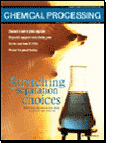Display problem ? Click HERE
Earlier post "Why bypass Non-Return Valve (NRV) ?" discussed the purpose of providing manual block valve across Non-Return Valve (NRV) on centrifugal pump discharge. Typical the purpose covers :
- Pump priming
- Pump warming
- NRV downstream section draining
Recommended :
Subscribe FREE - Chemical Processing

Now the question is focus on pump warming. What is the basis of setting this recycle flow rate ? Lets first define the purpose, how it is implemented and how to set the flow.
Purpose
The main purpose of the bypass line is to maintain a minimum temperature different between the pump (and associate piping ) and the pump suction fluid temperature to avoid temperature shock in the event of standby pump is started-up automatically.
How it is implemented ?
The bypass can be
- fixed restriction orifice (RO) or;
- non-return valve (NRV) with hole or;
- globe valve
The bypass flow rate should be sufficient to cater for :
i) Start-up : pump and associate piping heat-up from minimum ambient to normal suction temperature within a reasonable time i.e. 2 hours
ii) Normal operation : heat leakage via insulation during normal operation
Tips
Generally above calculation are time consuming. Experience based approach may be taken where setting the RO / NRV hole size as 6-8 mm or install a one (1) in globe valve.
Related Post
Related Post
- Removal of Specific Heat ratio (k) in the Mach No. & Critical Pressure Calculation
- Two Useful Equations For Flow Conversion between Air - Vapor & Actual - Standard
- Potential Problem associate with Double NRV in Series within a Line
- Restrcition Orifice Used in Many Applications in Different Manners
- A refresh to Process Engineer on few phenomenons in restriction orifice
- Why Restriction Orifice is some distance from Blowdown valve ?
No comments:
Post a Comment